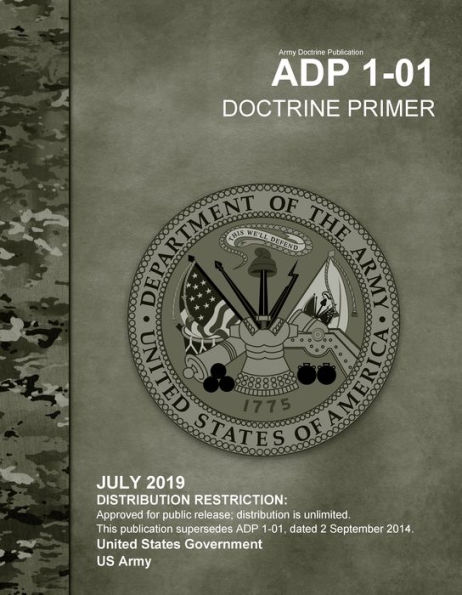This manual, Army Doctrine Publication ADP 1-01 Doctrine Primer July 2019, guides Army professionals (both Soldiers and Department of the Army Civilians) in their understanding of the entire body of professional knowledge and beliefs that shape the art and science of their profession. It addresses what doctrine is, why it is important, and which major ideas underlie it. The publication also discusses the most important taxonomies and terms used in the conduct of operations and the way they fit together as a single coherent whole. The principal audience for the ADP 1-01 is all members of the Army Profession.
ADP 1-01 applies to the Active Army, Army National Guard/Army National Guard of the United States, and United States Army Reserve unless otherwise stated.
Doctrine is dynamic and changing. It is based on lessons learned in current operations and training, from adaptive enemies, and after changes in force structure, technology, and social values. This publication provides the basic information necessary to understand Army doctrine and the ways it changes. It clarifies why various constructs exist and how they all fit together. It is a guide for professionals about the language of the profession.
Starting with Baron von Steuben's Regulations for the Order and Discipline of the Troops of the United States, doctrine in various forms has guided the Army through peacetime and war. Lessons learned from world wars and other operations shaped and codified how Army forces operated. (Army forces refers to Army organizations whose role is to conduct operations in the field. The Army refers to the Army as an institution.) In the early 1900s, Army doctrine consisted of fewer than 40 field service regulations and drill manuals. Gradually, doctrine grew to over 500 field manuals. Although they provided tactics and procedures, these publications lacked a clear hierarchy that served to both categorize and prioritize information. Leaders sometimes struggled to determine what was truly important for all professionals and what was important only to a branch or functional area. Additionally, as doctrine evolved, it saw a prolific growth of terms and expressions used. This growth sometimes obscured the relationship of terms and expressions such that Soldiers and their leaders did not clearly understand them.
The Army transition required a re-examination of Army doctrine. This transition moved the Army's focus more on readiness for large-scale combat against peer threats since 2015 and the 2018 National Defense Strategy, which had been heavily influenced by operations of the past 20 years. The 2017 version of FM 3-0 subsequently drove revisions to doctrine across all warfighting functions to ensure doctrinal publications adequately addressed both large-scale ground combat operations and those elements of the multi-domain operations future concept that could be implemented with the Army's currently fielded capabilities. As part of the effort, the Army decided to combine Army doctrine publications (known as ADPs) with their associated Army doctrine reference publications (known as ADRPs) to reduce redundancy. The Army continues to revise field manuals (known as FMs) and Army techniques publications (known as ATPs), as appropriate. These revisions make publications relevant to near-term operational environments and ensure Army doctrine is balanced to support Army forces conducting operations across the competition continuum and the range of military operations.
Leaders and Soldiers must understand what Army doctrine is, what its purpose is, how it is organized, and why its information is important. The precursor to this understanding is a definitive text on the why of Army doctrine—a doctrine primer. The doctrine primer becomes the standard for evaluating future doctrine; it allows the Army to discipline the establishment of terms and the categorization of operational knowledge.
Chapter 1 first looks at what doctrine is and why it is important. Chapter 2 examines the doctrine landscape—the structure of doctrine, types of doctrine, the relationship of doctrine to concepts and lessons learned, and reasons for doctrine changes. Chapter 3 looks at the foundations of doctrine. Chapter 4 examines the terms and taxonomies of current doctrine. Finally, chapter 5 examines how the taxonomies work together to facilitate the conduct of operations. The introductory figure on page vi illustrates the logic associated with doctrine. The introductory table addresses modified terms.



